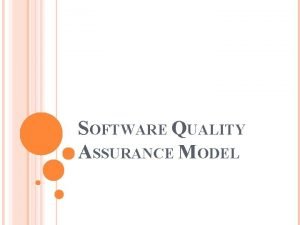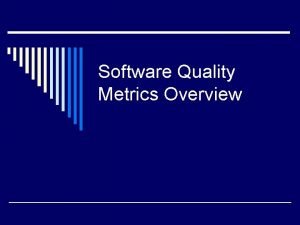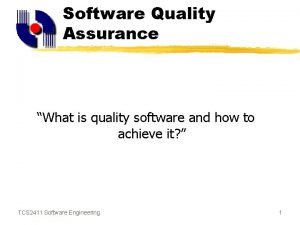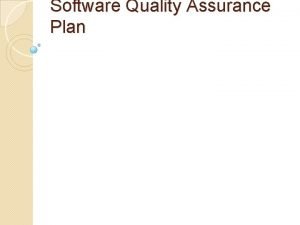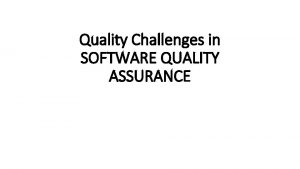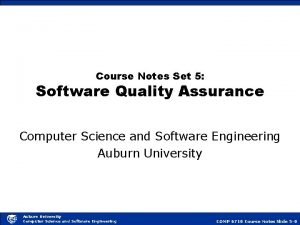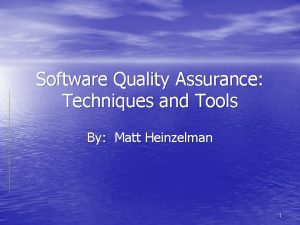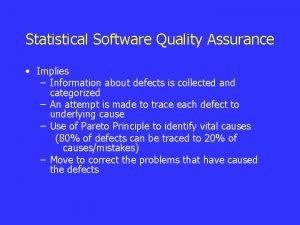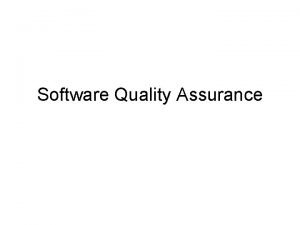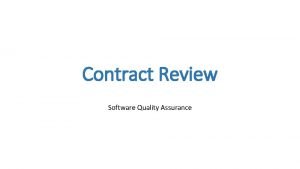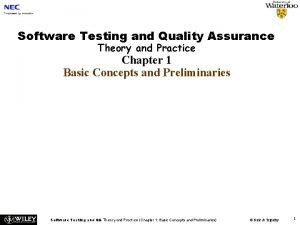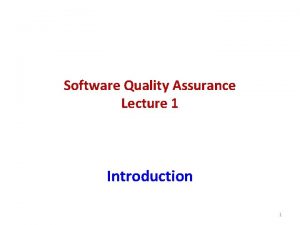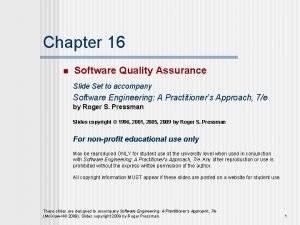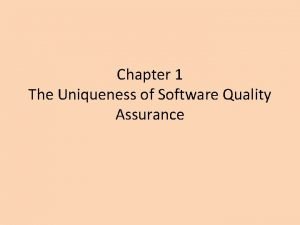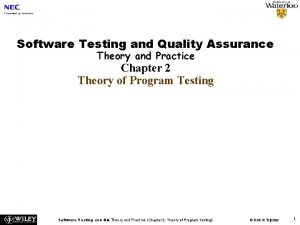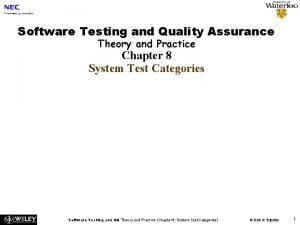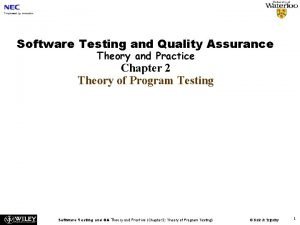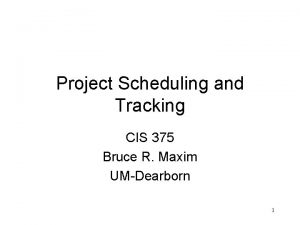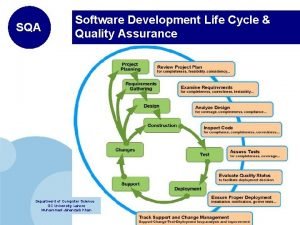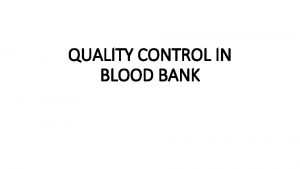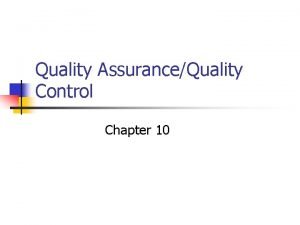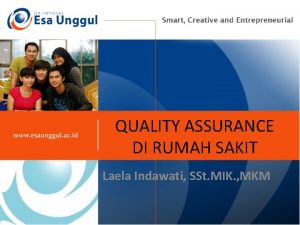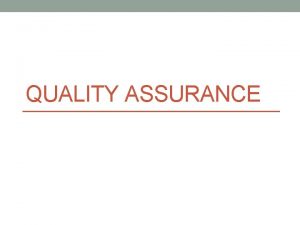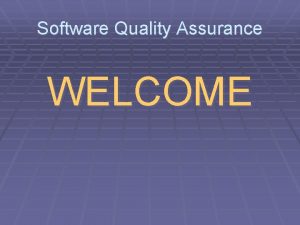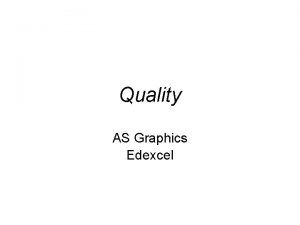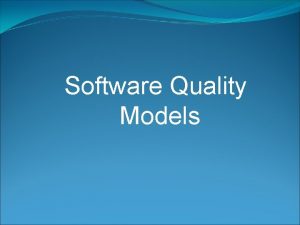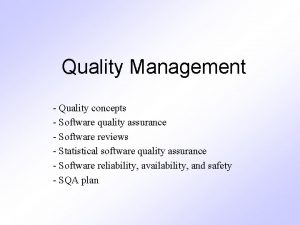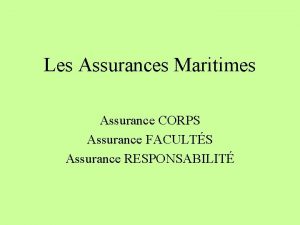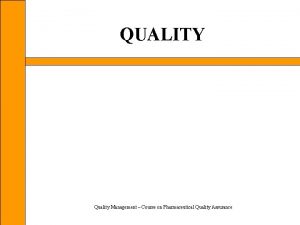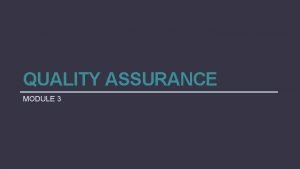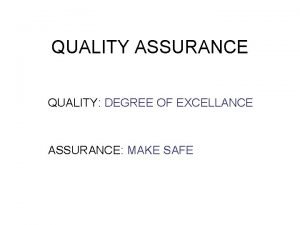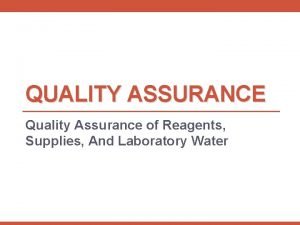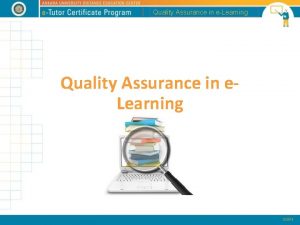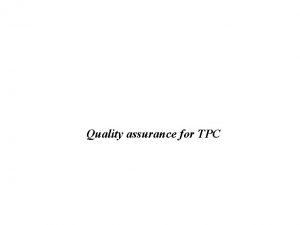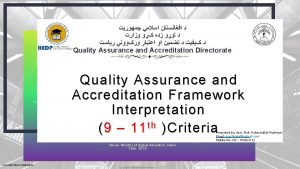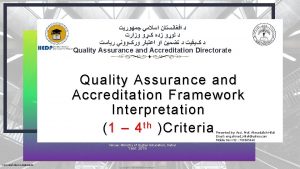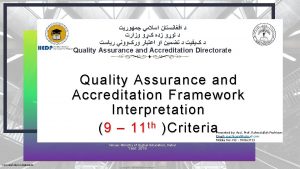Course 4 Software Quality Assurance Software Quality Models



![SQA – extended [Galin] A systematic, planned set of actions necessary to provide adequate SQA – extended [Galin] A systematic, planned set of actions necessary to provide adequate](https://slidetodoc.com/presentation_image_h2/547db006c59e185fdfc006070c6b59aa/image-4.jpg)






























- Slides: 34

Course 4 Software Quality Assurance & Software Quality Models S. Motogna - Software Quality

Software quality assurance • IEEE definition: 1. A planned and systematic pattern of all actions necessary to provide adequate confidence that an item or product conforms to established technical requirements. 2. A set of activities designed to evaluate the process by which the products are developed or manufactured. Contrast with quality control. S. Motogna - Software Quality

of technical Software quality. Specification assurance Software development process requirements • IEEE definition: 1. A planned and systematic pattern of all actions necessary to provide adequate confidence that an item or product conforms to established technical requirements. 2. A set of activities designed to evaluate the process by which the products are developed or manufactured. Contrast with quality control. S. Motogna - Software Quality
![SQA extended Galin A systematic planned set of actions necessary to provide adequate SQA – extended [Galin] A systematic, planned set of actions necessary to provide adequate](https://slidetodoc.com/presentation_image_h2/547db006c59e185fdfc006070c6b59aa/image-4.jpg)
SQA – extended [Galin] A systematic, planned set of actions necessary to provide adequate confidence that the software development process or the maintenance process of a software system product conforms to established functional technical requirements as well as with the managerial requirements of keeping the schedule and operating within the budgetary confines S. Motogna - Software Quality

IEEE Extended Systematic, planned actions � � Software Development Process � � Software Maintenance � � � � Functional Technical Requirements Scheduling Budget control ISO 9003 & CMM S. Motogna - Software Quality

SQ Assurance vs. SQ Control • Systematic activities throughout the development and maintenance – prevent, detect, correct errors • Minimize costs of quality • Set of activities – reject products that do not qualify • Part of SQ assurance activity S. Motogna - Software Quality

Objectives of SQA – process oriented 1. Software will conform to functional technical requirements 2. Software will conform to managerial scheduling and budgetary requirements 3. Improvement and efficiency of software development and SQA – improve technical and managerial requirements + reduce costs S. Motogna - Software Quality

Objectives of SQA – product oriented 1. Software maintenance activities will conform to functional technical requirements 2. Software maintenance activities will conform to managerial scheduling and budgetary requirements 3. Improvement and efficiency of software maintenance and SQA – improve technical and managerial requirements + reduce costs S. Motogna - Software Quality

Software Quality Models • • • Mc. Call (1977) – classic – 11 factors Evans & Marciniak (1987) – 12 factors Deutsch & Willis (1988) – 15 factors ISO 9126 (2001) – 6 factors ISO 25010 (2011) – 8 factors S. Motogna - Software Quality

Terminology • Hierarchical structure: set of factors with subfactors • Factor/ subfactor = characteristics / subcharacteristics • In Mc. Call model – same subfactor part of different factors • Rest of the models: tree structure S. Motogna - Software Quality

Mc. Call Model • 11 factors – grouped in 3 categories: – Product operation factors - deals with requirements that directly affects software operation: Correctness, Reliability, Efficiency, Integrity, Usability – Product revision factors - deals with requirements affecting software maintenance activities: Maintainability, Flexibility, Testability – Product transition factors - deals with requirements affecting adaptation and integration: Portability, Reusability, Interoperability S. Motogna - Software Quality

S. Motogna - Software Quality

Other models Evans & Marciniak Deutsch & Willis • Exclude testability • Add verifiability • Add expandability • • • Exclude testability Add verifiability Add expandability Add safety Add manageability Add survivability ØExpandability + survivability – resemble flexibility + reliability ØTestability – part of maintainability S. Motogna - Software Quality

FURPS Model • Developed by Hewlett Packard • FURPS: – Functionality - is assessed by evaluating the features and capabilities of the delivered program and the overall security of the system. – Usability - is assessed by considering human factors, overall aesthetics, look and feel and easy of learning. – Reliability - is assessed by measuring the frequency of failure, accuracy of output, the mean-time-to-failure(MTTF), ability to recover from failure. – Performance - is assessed by processing speed, response time, resource utilization, throughput and efficiency. – Supportability - is assessed by the ability to extend the program (extensibility), adaptability, serviceability and maintainability. S. Motogna - Software Quality

ISO 9126 Quality Factors • The ISO 9126 standard identifies six key quality attributes: – Functionality - degree to which software satisfies stated needs. – Reliability - the amount of time the software is up and running. – Usability - the degree to which a software is easy to use. – Efficiency - the degree to which software makes an optimum utilization of the resources. – Maintainability - the ease with which the software can be modified. – Portability - the ease with which a software can be migrated from one environment to the other. S. Motogna - Software Quality

ISO 25010 System and software quality model S. Motogna - Software Quality

Mc. Call model • See Mc. Call. pdf in course directory • Approach: – Determine a set of quality factors – Develop a set of criteria for each factor – Define metrics for each criterion – Validate metrics – Translate results into guidelines • Start with 55 features - group S. Motogna - Software Quality

S. Motogna - Software Quality

Case study - Correctness • Definition: Extent to which a program satisfies its specifications and fulfills the user's mission objectives. • Life-cycle involvement: – Measured in development: analysis, design, implementation – Impact realized in: testing, operation, maintenance • Criteria: – Traceability – Consistency – Completeness • Criteria definition • Metrics & criteria evaluation S. Motogna - Software Quality

• Traceability: Those attributes of the software that provide a thread from the requirements to the implementation with respect to the specific development and operational environment. • Consistency: Those attributes of the software that provide uniform design and implementation techniques and notation. – Reliability + Maintainability • Completeness: Those attributes of the software that provide full implementation of the functions required. S. Motogna - Software Quality

Metrics for criteria • Mc. Call. pdf: – pg 64 – Computation – pg 90 - Explanation S. Motogna - Software Quality

• Project assignment: – 1 st step: choose your SQ model S. Motogna - Software Quality

PORTABILITY S. Motogna - Software Quality

Portability • Definition: Effort required to transfer a program from one hardware configuration and/or software system environment to another. • Impact: – Measured: • Design • Code – Realized: transition S. Motogna - Software Quality

Mc. Call Portability Modularity • struct. of indep. modules • in other 6 factors Selfdescriptiveness • explanations • Also in maintainability, testability, portability & reusability Machine Independence • hardware indep. • also in reusability S. Motogna - Software Quality Software System Independence • indep. of OS, utilities, I/O • also in reusability

ISO 25010 Portability Adaptability Degree to which a product or system can effectively and efficiently be adapted for different or evolving hardware, software or other operational or usage environments Instability Degree of effectiveness and efficiency with which a product or system can be successfully installed and/or uninstalled in a specified environment S. Motogna - Software Quality Replaceability Degree to which a product can replace another specified software product for the same purpose in the same environment.

Why? Ø Software life ≈15 years vs. hardware life ≈ 4 -5 years Ø Software implemented ≈ 3 hardware config. Ø Porting less expensive than implementing Ø Greater market S. Motogna - Software Quality

The 7 dimensions of portability 1. 2. 3. 4. 5. 6. 7. Operating systems Processor architecture Compiler & language features GUI environment Regions Hardware devices … S. Motogna - Software Quality

Issues in OS portability I/O, encode char, organize files, allocate resources Functionality not included in standard: web server, database engine, mail transfer engine standardization POSIX - API Compatibility/ emulation layer Application binary interface S. Motogna - Software Quality

Issues in Processor Architecture portability • Data type properties – size + operations • Data representation – alignment • Machine-specific code JAVA S. Motogna - Software Quality

Approaches in GUI portability • Ignore: platform dependent app. • Emulation layer: use libraries for transformation • Portability layer: isolate GUI elem. • Portable platform: ex. Java – own API for GUI • HTML or AJAX-based layer Mobile application S. Motogna - Software Quality

Issues in region portability • Internationalization: generalization process of creating programs that can be easily ported across different regions • Localization: particularization effort required to port a program to a given region Messages Character set Cultural issues S. Motogna - Software Quality Date Time Currency

Portability today SOA • Less technology dependant • Internal platform independence through SOA Open Source • Less coding, more composition • Portability of parts Tinderbox http: //wwwarchive. mozilla. org/projects/tinderbox/ S. Motogna - Software Quality

Portability metrics • effort required to install the software • Deployment + installation • Change to new specs or operating environments • Compliant with … [Yes/no] Adaptability Instalability Conformance Replaceability • Similar to compliance for functionality • Compliant with 3 rd party compon: DB, app. Server • Compatible with… [Yes/No] • plug&play of compon. • Difficult to evaluate S. Motogna - Software Quality
 Software quality assurance models
Software quality assurance models Quality control and quality assurance
Quality control and quality assurance Plan quality management pmp
Plan quality management pmp Quality metrics pmp
Quality metrics pmp Process of nursing audit
Process of nursing audit Quality improvement vs quality assurance
Quality improvement vs quality assurance Basic concept of quality management
Basic concept of quality management Types of software metrics
Types of software metrics Software quality assurance iso standards
Software quality assurance iso standards Sqa plan
Sqa plan Software quality assurance challenges
Software quality assurance challenges Maiborn wolff
Maiborn wolff Software quality assurance notes
Software quality assurance notes Software testing and quality assurance theory and practice
Software testing and quality assurance theory and practice Sqa tools and techniques
Sqa tools and techniques Statistical quality assurance in software engineering
Statistical quality assurance in software engineering Statistical software quality assurance
Statistical software quality assurance Statistical sqa
Statistical sqa Contract review in software quality assurance
Contract review in software quality assurance The quality revolution
The quality revolution Introduction to software quality assurance
Introduction to software quality assurance Software quality assurance framework
Software quality assurance framework Software quality assurance slideshare
Software quality assurance slideshare Uniqueness of software quality assurance
Uniqueness of software quality assurance Software quality assurance agency
Software quality assurance agency Software testing and quality assurance theory and practice
Software testing and quality assurance theory and practice Software quality assurance agency uk
Software quality assurance agency uk Software testing and quality assurance theory and practice
Software testing and quality assurance theory and practice Software testing and quality assurance theory and practice
Software testing and quality assurance theory and practice Project scheduling and tracking software quality assurance
Project scheduling and tracking software quality assurance Sdlc quality assurance
Sdlc quality assurance Quality assurance in blood bank
Quality assurance in blood bank Quality control purpose
Quality control purpose Quotes on quality assurance
Quotes on quality assurance Contoh quality assurance di rumah sakit
Contoh quality assurance di rumah sakit
